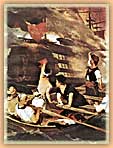 |

From the beginning of the Revolution it was clear that the small and inadequately equipped Greek ships were not capable of matching Ottoman ships in an open conflict. Thus, other tactics, such as obstructing the movement of the Ottoman fleet, were adopted. The main targets were the convoys which transported troops and provisions to the besieged forts of the Peloponnese and Rumeli. Moreover, the attempts of the Greek fleet to raise the siege of the forts and reinforce the besieged Greeks with provisions and armed men were frequent. Finally, the Aegean Islands had to be defended against the action of the Ottoman fleet.
In these operations the Ottoman fleet was damaged by the
use of a naval tactic that undermined the Ottomans' supremacy
in weaponry. This was the use of fireships in noctural sorties.
Fireships were small ships loaded with inflammable and explosive
materials, which were attached to the Ottoman ships and blown
up with them. These hazardous attacks, which demanded agile
manipulation so that the fireship could be attached to the
Ottoman ship, and luck, so that operation remain secret, resulted
in certain impressive actions. One such was the destruction
of the Ottoman flagship off Cesme in July 1822 by Kanaris.
Such actions provoked fear among the crews and hesitancy in
the movements of the Ottoman fleet. There were also unsuccessful
actions such as that of August 1825 and June 1827 in what
was probably most ambitious operation of the Greek fleet:
the aim was to blow up the Egyptian fleet in the harbour of
Alexandria. A successful Greek naval battle occurred off Hydra
and Spetses in October 1822, in the gulf of Geronta in August
1824 and in Kavo Doro in May 1825, in which Pipinos, Miaoulis
and Sachtouris played distinguished roles respectively. Despite
the action of Kanaris and other fire-raisers, the ships of
the Ottoman fleet did not meet great difficulties in conducting
their operations. The supremacy in weaponry of the Ottoman
ships did not leave many possibilities of action open to the
Greek navy. The lack of coordination and especially the occasional
occupation of the Greek ships with war operations made Greek
position even worse.
Trade and piracy constituted alternate activities which ensured the maintenance of the ships and the payment of the crew. But despite these benefits, such activities undermined the operational effectiveness of the Greek navy and, piracy in particular, provoked the opposition of the Great Powers, who were interested in maintaining the safety of commercial sea routes.
Thus, from the first months of 1828, Governor Ioannis Kapodistrias set limits on piracy, a policy that was accomplished thanks to Andreas Miaoulis.
|
 |